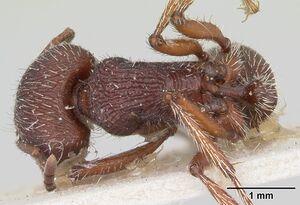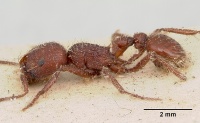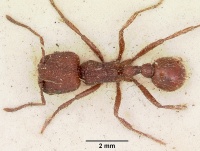Pogonomyrmex bispinosus
| Pogonomyrmex bispinosus | |
|---|---|

| |
| Scientific classification | |
| Kingdom: | Animalia |
| Phylum: | Arthropoda |
| Class: | Insecta |
| Order: | Hymenoptera |
| Family: | Formicidae |
| Subfamily: | Myrmicinae |
| Tribe: | Pogonomyrmecini |
| Genus: | Pogonomyrmex |
| Species group: | bispinosus |
| Species: | P. bispinosus |
| Binomial name | |
| Pogonomyrmex bispinosus (Spinola, 1851) | |
Pogonomyrmex bispinosus is only known from central portions of Chile (Valparaíso and Metropolitan Regions) at elevations estimated to range from sea level to >1000 m in the Valdivian Temperate Forests and Chilean Matorral ecoregions as defined by Olson et al. (2001). Nothing is known about the biology of P. bispinosus other than that males and/or ergatoid queens have been collected from 21 November to 29 January. (Johnson 2015)
Identification
Johnson (2015) - Worker Within the P. bispinosus-group, the combination of: (1) superior propodeal spines well-developed, (2) larger (HW = 1.75–2.05 mm), (3) body concolorous tannish-brown to reddish-brown, (4) in frontal view and from posterior margins of head looking down over cephalic dorsum, frontal lobes enlarged, lateral margins convex, projecting at a strong vertical orientation relative to cephalic dorsum uniquely characterize this species.
Ergatoid Queen This caste is diagnosed by: (1) ergatoid, with small ocelli on head and mesosoma lacking all morphological structures related to wings, (2) in dorsal view, pronotum large, well-developed; mesoscutum poorly-developed, anterior margin barely surpassing humeral shoulders of pronotum, (3) superior propodeal spines well-developed, length greater than 0.6x distance between their bases, (4) inferior spines well-developed, wider than tall, broadly rounded, (5) in dorsal view, petiolar node globular, anterior margin broadly rounded, (6) in dorsal view, postpetiole notably wider than long, (7) rugae on dorsum of postpetiole lacking or faint to weak, rarely crossing entire surface, and (8) body mostly concolorous tannish-brown to reddish-brown.
Male This caste is diagnosed by: (1) first gastral tergum lacking striae, (1) in dorsal view, anteromedial surface of petiolar node and usually apex weakly to strongly concave, (2) dorsum of postpetiole with weak longitudinal rugae, (3) transverse rugae usually present between frontal lobes, and (4) notauli present.
Pogonomyrmex bispinosus is restricted to Chile, and it is distinguished from all Chilean congeners by: (1) well-developed psammophore, (2) first gastral tergum lacks striae, (3) dorsum of postpetiole lacks transverse striae, (4) body concolorous tannish-brown to reddish-brown, and (5) in frontal view and from posterior margins of head looking down over cephalic dorsum, the frontal lobes are enlarged and the lateral margins are convex, projecting at a strong vertical orientation relative to the cephalic dorsum.
Keys including this Species
- Key to Pogonomyrmex queens of South American
- Key to Pogonomyrmex workers of South American
- Key to South American Pogonomyrmex
- Pogonomyrmex de Sur America clave a las obreras
- Pogonomyrmex de Sur America clave a las reinas
Distribution
Latitudinal Distribution Pattern
Latitudinal Range: -33.050462° to -37.290093°.
| North Temperate |
North Subtropical |
Tropical | South Subtropical |
South Temperate |
- Source: AntMaps
Distribution based on Regional Taxon Lists
Neotropical Region: Chile (type locality).
Distribution based on AntMaps
Distribution based on AntWeb specimens
Check data from AntWeb
Countries Occupied
| Number of countries occupied by this species based on AntWiki Regional Taxon Lists. In general, fewer countries occupied indicates a narrower range, while more countries indicates a more widespread species. |

|
Estimated Abundance
| Relative abundance based on number of AntMaps records per species (this species within the purple bar). Fewer records (to the left) indicates a less abundant/encountered species while more records (to the right) indicates more abundant/encountered species. |

|
Biology
Castes
Images from AntWeb
  
| |
| Worker. Specimen code casent0173348. Photographer April Nobile, uploaded by California Academy of Sciences. | Owned by MHNG, Geneva, Switzerland. |
Nomenclature
The following information is derived from Barry Bolton's Online Catalogue of the Ants of the World.
- bispinosus. Atta bispinosa Spinola, 1851a: 244 (w.q.) CHILE. Combination in Pogonomyrmex: Mayr, 1868b: 170. [Misspelled as brevispinosus by Santschi, 1925d: 223.] See also: Gallardo, 1932b: 130.
Unless otherwise noted the text for the remainder of this section is reported from the publication that includes the original description.
Description
Johnson (2015):
Worker
Neotype (n = 11). HL 1.90 (1.67–2.00); HW 1.88 (1.75–2.05); MOD 0.38 (0.32–0.40); OMD 0.40 (0.36–0.45); SL 1.50 (1.27–1.48); PNW 1.15 (1.06–1.27); HFL 1.79 (1.59–1.98); ML 1.96 (1.86–2.17); PW 0.47 (0.46–0.54); PPW 0.68 (0.60–0.74). Indices: SI 79.79 (67.32–77.47); CI 98.95 (97.47–105.59); OI 20.21 (15.61–20.21); HFI 95.21 (84.13–100.00).
Head subquadrate to quadrate (CI = 97.47–105.59), widest just posterior to eyes; posterior margin flat to weakly concave in full-face view. Longitudinal rugae on cephalic dorsum prominent, wavy to irregular; in full-face view, medial rugae diverging weakly toward posterior corners of head. In profile, rugae posterior to eyes converging near vertex. Cephalic interrugae strongly granulate-punctate, dull to weakly shining; vertex rugose. In frontal view and from posterior margins of head looking down over cephalic dorsum, frontal lobes enlarged, lateral margins convex, projecting at a strong vertical orientation relative to cephalic dorsum. Anterior margin of clypeus concave; lateral lobes with broad, blunt, sometimes inconspicuous tooth-like process below each antennal socket; dorsal surface with several subparallel, longitudinal rugae. Mandible with six teeth; mandibular dorsum coarsely rugose. MOD ranging from 0.16-21x HL. In profile, eyes situated slightly anterior to middle of head, OMD = 1.00–1.30x MOD. Antennal scapes moderately long (SI = 67.32–79.79), failing to reach vertex by length of basal funicular segment; base of scape flattened dorsoventrally, ventral surface widened at base with moderately well-developed inferior basal flange, margin of flange weakly carinate; entire scape with weak longitudinal striae, moderately granulate-punctate, weakly shining. Psammophore well-developed.
Mesosomal profile weakly convex; all mesosomal surfaces with prominent irregular rugae to rugoreticulate. Dorsum of pronotum with irregular, transverse rugae to rugoreticulate, pronotal sides rugoreticulate or with coarse, irregular rugae traversing posteroventrally; dorsum of mesonotum and propodeum with irregular longitudinal rugae, irregular rugae on mesopleura longitudinal or traversing posterodorsally. Interrugae on mesosoma weakly to strongly granulate, dull to weakly shining. Superior propodeal spines moderately well-developed, length about 0.6–0.8x distance between their bases. Inferior propodeal spines poorly-developed, consisting of a broadly rounded process. Propodeal spiracles narrowly ovate facing posterad. Legs weakly to moderately coriarious, weakly shining.
Peduncle of petiole about 0.8x as long as petiolar node, anteroventral margin with poorly to well-developed rounded process. In profile, petiolar node asymmetrical with anterior surface shorter than posterior surface; apex broadly rounded. In dorsal view, petiolar node longer than wide, widest near spatulate anterior margin. Posterior surface of petiolar node with weak to coarse, irregular, longitudinal, oblique, or transverse rugae to rugoreticulate; interrugae on all surfaces weakly to moderately granulate-punctate, weakly shining. Dorsum of postpetiole convex in profile; in dorsal view, widest near posterior margin, narrowing to anterior margin, maximal width usually greater than length, weakly to moderately coriarious, weakly shining. First gastral tergum moderately coriarious, weakly shining to smooth and shining.
Erect whitish to cream colored pilosity moderately abundant on head, short and similar in length, usually longer along posterior margin; longest hairs not exceeding MOD. Moderately abundant erect to semidecumbent pilosity on scape; abundant decumbent hairs on funicular segments. Legs with moderately abundant, long, semidecumbent, whitish to cream colored setae. Mesosoma, petiolar node, postpetiole, first gastral tergum with moderately dense, erect, whitish to cream colored setae, often similar in length, longest hairs approaching to exceeding MOD. Body concolorous tannish-brown to reddish-brown.
Queen
(n = 2). HL 2.27–2.29; HW 2.43–2.57; MOD 0.38–0.46; OMD 0.54–0.55; SL 1.61–1.61; PNW 1.40–1.52; HFL 2.06–2.08; ML 2.85–2.83; PW 0.77–0.79; PPW 1.06–1.09. Indices: SI 62.65–62.65; CI 106.11–113.22; OI 14.79–18.93; HFI 80.93–84.77.
Ergatoid, with small ocelli on head. In full-face view, head slightly wider to wider than long (CI = 106.11–113.22), widest just posterior to eyes, posterior margin weakly concave. Longitudinal rugae on cephalic dorsum prominent, wavy to irregular; in full-face view, medial rugae diverging weakly toward posterior corners of head; vertex weakly to moderately rugose; interrugae on cephalic dorsum and vertex weakly to moderately granulate-punctate, weakly shining. Mandible with six teeth, dorsal surface coarsely rugose. Psammophore welldeveloped.
Mesosomal segments largely fused, lacking all morphological structures related to wings. In dorsal view, pronotum large, well-developed; mesoscutum poorly-developed, anterior margin barely surpassing humeral shoulders of pronotum. All mesosomal surfaces with subparallel, regular, wavy, or irregular rugae; interrugae weakly to moderately granulate-punctate, weakly shining; propodeum with well-developed superior and inferior spines; inferior spines wider than tall, broadly rounded. Peduncle of petiole about 0.8x as long as petiolar node, anteroventral margin with weak process. In profile, petiolar node asymmetrical with anterior surface notably shorter than posterior surface, apex subangulate to rounded. In dorsal view, petiolar node globular, posterior surface with irregular rugae, interrugae weakly to moderately granulate-punctate, weakly shining. In dorsal view, postpetiole wider than long; dorsum with faint to weak irregular rugae, moderately granulate-punctate, weakly shining. First gastral tergum weakly coriarious, weakly shining to smooth and shining. Most body surfaces with moderately abundant suberect to erect, medium-length, white to yellowish setae. Body concolorous tannish-brown to reddish-brown.
Male
(n = 6). HL 1.37–1.63; HW 1.41–1.71; MOD 0.46–0.55; OMD 0.20–0.27; SL 0.41–0.51; HFL 1.82–2.13; ML 2.41–2.71; PW 0.50–0.65; PPW 0.69–0.86. Indices: SI 26.28–32.00; CI 102.92–107.24; OI 31.58–34.67; HFI 114.47–132.62.
Type Material
Neotype worker [ANTWEB1008879] Los Angeles County Museum of Natural History designated by Johnson, 2015: 61, CHILE, Valparaíso: Petorca Province, 3 km N Zapallar, 28 October 1972, J.H. Hunt, #952 (previous holotype worker from CHILE, Santa Rosa, presumed lost or destroyed).
The type of P. bispinosus was not located during this study and it is presumably lost or destroyed. However, salient features of the present species correspond with the description by Spinola (1851): (1) entirely ferruginous red, (2) dorsum of postpetiole strongly punctate (lacking transverse rugae), and (3) first gastral tergum smooth and shining. In combination, these characters uniquely characterize P. bispinosus from all Chilean congeners. In addition, all material examined during this study was from the Metropolitan and Valparaíso Regions, which meets the geographical criteria for P. bispinosus. Snelling & Hunt (1975) also identified these same workers as P. bispinosus, listing diagnostic characters as: (1) dorsum of postpetiole punctate and lacking transverse striae, and (2) scape thickened near the base. Moreover, Spinola’s description of P. bispinosus, along with absence of morphologically similar congeners in Chile, leave no doubt as to the identity of P. bispinosus (see also Snelling & Hunt, 1975).
Etymology
The naming of this species apparently refers to the two well-developed superior propodeal spines, which Spinola described as two dorsal spines, straight and equally vertical, slightly in front of posterior border.
Determination Clarifications
Spinola (1851) described P. bispinosus from one worker that was collected at Santa Rosa, Chile (= Santa Rosa de los Andes, Valparaíso Region), and from sexuals (queens and males) taken during a mating flight at Tucapel, Chile. Emery (1906) believed the worker and sexuals were different species, and he assigned the sexuals as P. bispinosus var. spinolae. I concur with Emery (1906) that the queens and males described by Spinola (1851) are not conspecific with workers; the sexuals are in the P. rastratus-group and are not treated herein.
References
- Gallardo, A. 1932c. Las hormigas de la República Argentina. Subfamilia Mirmicinas, segunda sección Eumyrmicinae, tribu Myrmicini (F. Smith), género Pogonomyrmex Mayr. An. Mus. Nac. Hist. Nat. B. Aires 37: 89-170 (page 130, see also)
- Johnson, R.A. 2015. A taxonomic revision of South American species of the seed-harvester ant genus Pogonomyrmex (Hymenoptera: Formicidae). Part I. Zootaxa 4029:1–142 (doi:10.11646/zootaxa.4029.1.1).
- Johnson, R.A. 2021. A taxonomic revision of South American species of the seed-harvester ant genus Pogonomyrmex (Hymenoptera: Formicidae). Part II. Zootaxa 5033, 1–230 (doi:10.11646/zootaxa.5033.1.1).
- Mayr, G. 1868b. Formicidae novae Americanae collectae a Prof. P. de Strobel. Annu. Soc. Nat. Mat. Modena 3: 161-178 (page 170, Combination in Pogonomyrmex)
- Spinola, M. 1851a. Insectos. Orden 7. Himenopteros. Pp. 153-569 in: Gay, C. Historia fisica y politica de Chile. Zoologia. Tomo 6. Paris: Maulde & Renon, 572 pp. (page 244, worker, queen described)
References based on Global Ant Biodiversity Informatics
- Cepeda-Pizarro J., J. Pizarro-Araya, and C. Bravo-Naranjo. 2018. The assemblage of epigean ants (Formicidae) inhabiting altered patches found in a latitudinal transect of coastal matorral of semiarid Chile. IDESIA (Chile) 36(2): 193-201.
- Gallardo A. 1932. Las hormigas de la República Argentina. Subfamilia Mirmicinas, segunda sección Eumyrmicinae, tribu Myrmicini (F. Smith), género Pogonomyrmex Mayr. Anales del Museo Nacional de Historia Natural de Buenos Aires 37: 89-170.
- Goetsch W. and C. Menozzi. 1935. Die Ameisen Chiles. Konowia 14: 94-102
- Goetsch, W., and C. Menozzi. "Die Ameisen Chiles." Konowia 14 (1935): 94-102.
- Johnson R. A. 2015. A taxonomic revision of South American species of the seed-harvester ant genus Pogonomyrmex (Hymenoptera: Formicidae). Part I. Zootaxa 4029(1):1-142
- Johnson Robert. 2014. List of South American species of Pogonomyrmex. Accessed on February 5th 2014 at http://www.asu.edu/clas/sirgtools/pogonomyrmex/SOUTHAMERICANPOGOS.htm
- Kempf W. W. 1970. Catálogo das formigas do Chile. Papeis Avulsos de Zoologia (São Paulo) 23: 17-43.
- Snelling R. R., and J. H. Hunt. 1975. The ants of Chile (Hymenoptera: Formicidae) Revista Chilena de Entomología 9: 63-129.

